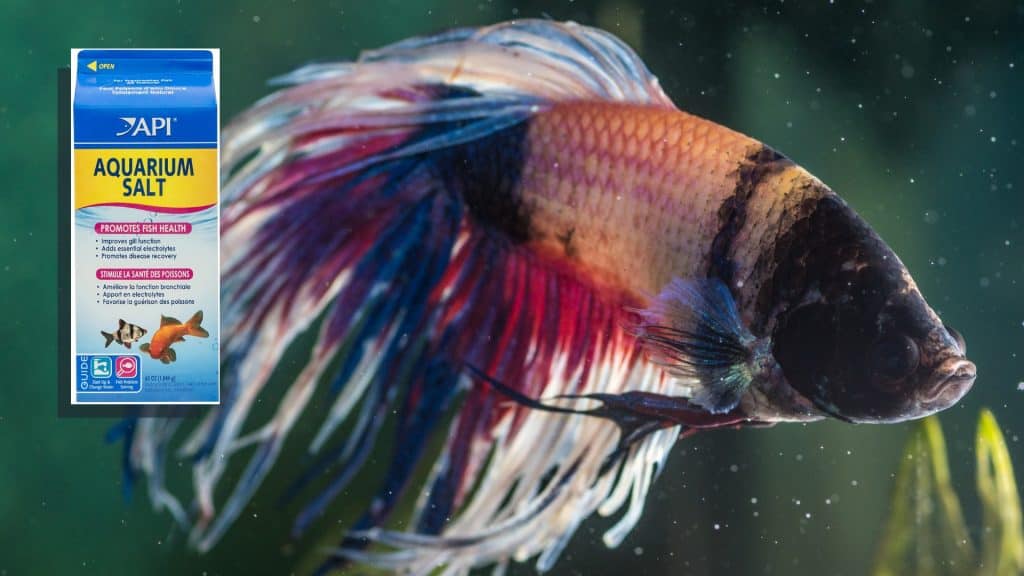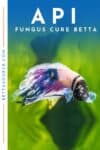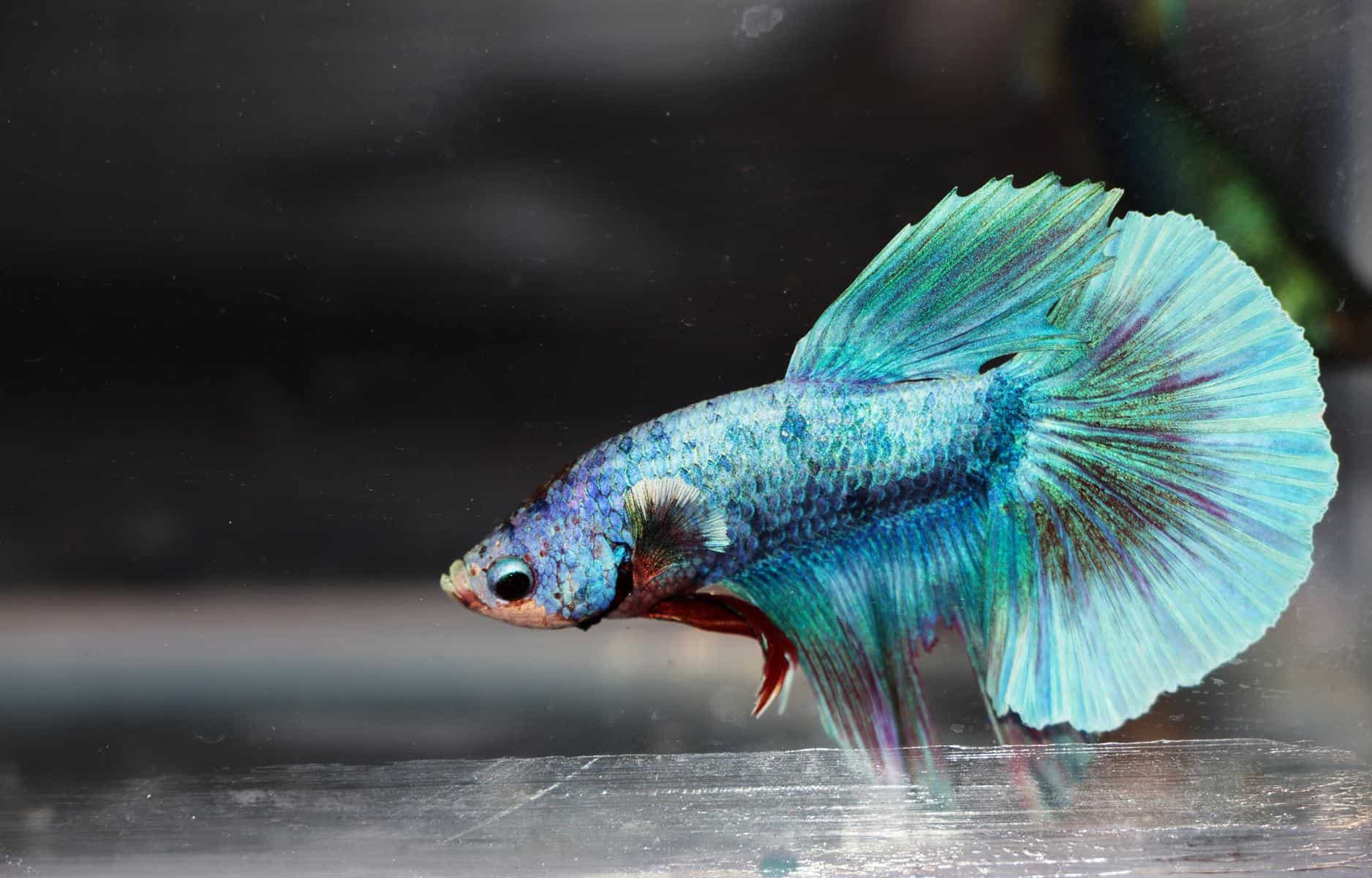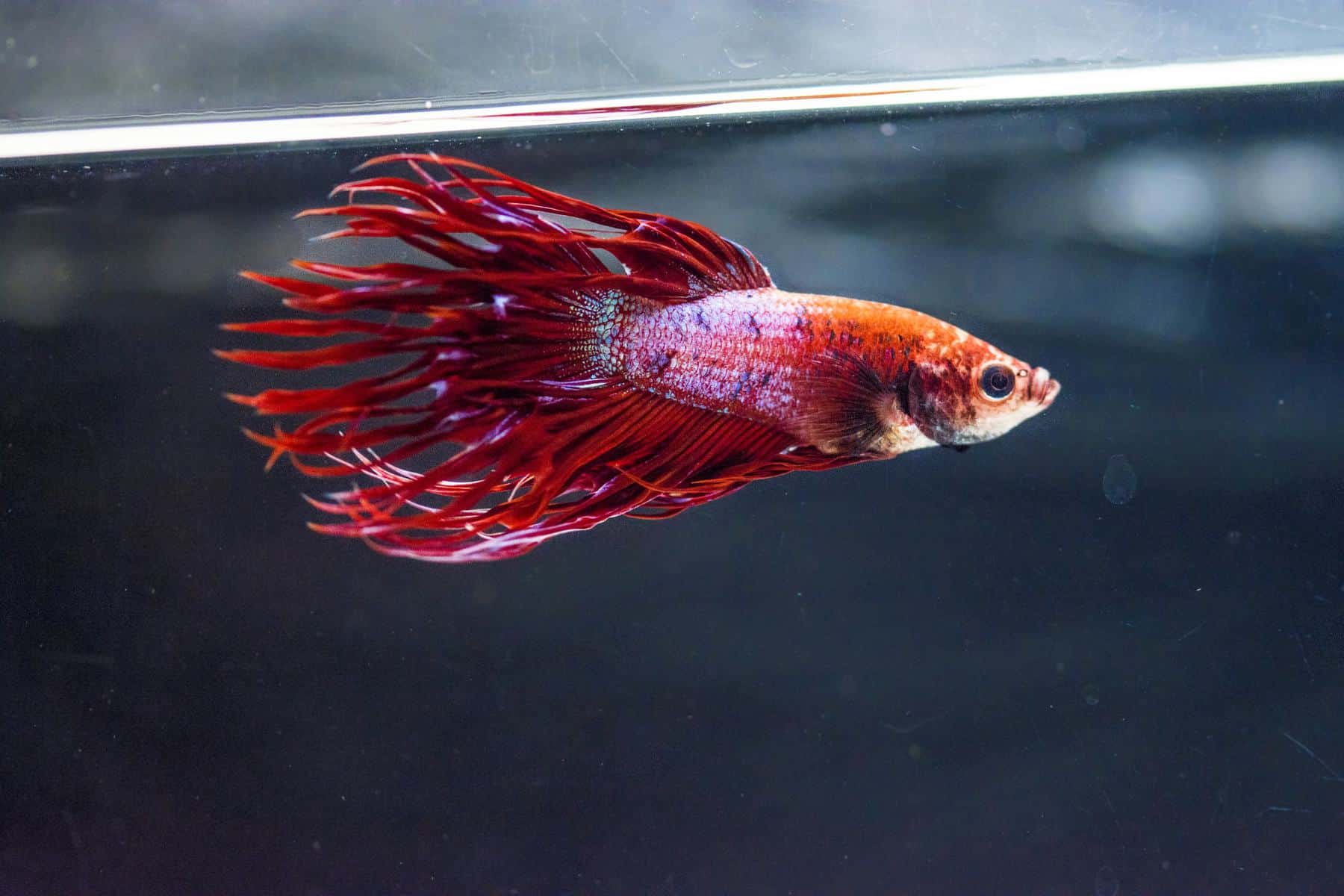Betta fish are generally pretty healthy characters, and they don’t get sick if you give them a nutritious, high-quality diet and keep their tank clean and well-maintained. However, there are a few common fish diseases that can affect breeds of betta fish, and fungus is one of them.
Fungus can often affect new fish that are stressed by transportation or poor living conditions at the pet store. Often, the betta arrives at his new home only to get sick a few days later. So, it’s important that you know how to diagnose and treat fungus if your betta buddy is affected.
Fungus can be fatal if you don’t treat it quickly. Read this guide to learn all about fish fungus and how to treat it.
What does fungus look like in betta fish?
The main symptoms of a betta fungal infection are white, cotton-like, fluffy growths on the head, mouth, and body of the fish.
Your betta will most likely begin flicking or rubbing against your tank decorations and the substrate in response to the irritation that the fungus causes. Affected fish have a poor appetite, aren’t as active as usual, lose their bright colors, and may clamp their fins against their sides, too.
What causes fungus in fish?
Fungal spores are often present in fish tanks, but they don’t usually cause problems unless the fish is weakened by poor water quality or stress.
That’s why fungal outbreaks commonly occur when you bring fishes home from the pet store where the living conditions may not have been ideal. Betta fish you buy online are often subjected to long journeys, and the stress of living in a small bag of stale water for hours can trigger a fungal infection.
Fungus is often associated with dirty, overcrowded tanks, too, which is yet another reason we hope you pay attention to keeping your betta’s aquarium clean and hygienic. If you’re not sure how to set up and clean your betta’s tank properly, take a look at this article.
What to do if your betta has a fungal infection
There are several important things you’ll need to do if you discover fungus on fish.
Move your betta to a healthy environment
Fungus is extremely contagious, so first of all, remove your betta to a clean quarantine tank away from his tank mates.
Don’t put living plants in the quarantine tank, as the salt and chemicals you’re going to use to treat your betta will probably kill them. Instead, stock the temporary betta fish tank with silk plants and betta hammocks to provide your pet with shelter and places to rest.
Upgrade or sanitize your betta’s home
Your betta will need to spend a couple of weeks in the quarantine tank, undergoing fungus treatment. So, take the opportunity to give your pet’s main aquarium a thorough cleaning.
If you have your betta in a very small tank, consider upgrading its home to an aquarium of 5 gallons or more. A larger tank means that fish waste will be more diluted, and the water will stay cleaner for longer periods of time.
- Remove algae from the glass using an algae magnet so you can clearly see the interior of the tank and your fish.
- Use an aquarium vacuum to deep-clean the gravel, removing all fish waste, decomposing plant matter, and uneaten fish food.
- Wash the filter media in dirty tank water (not tap water) to get rid of any accumulations of sludge that prevent the water from flowing through the media properly. Replace any spent filter media.
- Make sure that the heater is working and is set to between 78 and 80 degrees Fahrenheit. Use an aquarium thermometer to monitor the temperature.
Now that your main betta tank is correctly set up and is a safe, welcoming environment for your pet, you can focus on getting him well again.
How to treat betta fungal infections
The treatment you use to tackle fungus depends to some extent on the organism that you’re dealing with.
Fungus around the betta’s mouth
Although the condition initially presents as a fungal infection, cottony growths and grayish-white areas around the fish’s mouth are often caused by bacteria, including Columnaris, rather than a fungus.
In these cases, we recommend that you treat the condition with a broad-spectrum, over-the-counter antibiotic, such as Maracyn Two, which you can buy from your local fish store or online.
Before using the treatment, you’ll need to remove any chemical filtration, such as Purigen resin or activated carbon before treatment, as those substances will remove the treatment from the water before it has a chance to work.
When using Maracyn Two, always be sure to follow the manufacturer’s guidelines carefully, and always complete the full course of treatment, even if your betta shows signs of improvement. That’s crucial, as the infection can still linger in the fish’s body, even if the outward signs have disappeared. If you stop treating the water too soon, the bacteria will simply reappear within a few days, and you’ll have to start treatment all over again.
Fungus on the betta’s head and body
If white, fluffy growths appear on the fish’s body, that’s most likely caused by a species of aquatic fungus.
The good news is that you can often treat the condition using aquarium salt or natural rock salt without the need to use drug therapy. If you can avoid using a chemical medication, that’s even better.
The prolonged use of drug treatments can cause your betta to build up a resistance to the chemicals they contain, and eventually, the medication won’t be as effective. So, if possible, make a natural solution your first port of call.
Using salt
To treat fungal infections with salt, always use rock salt or, preferably, API aquarium salt.
- Contains one (1) API AQUARIUM SALT Freshwater Aquarium Salt 67-Ounce Box
- Promotes fish health and disease recovery with increased electrolytes
- Improves respiration for fish in freshwater aquariums
Do not use table salt, Epsom salt, or marine salt. Those substances are harmful to your betta fish.
Start by lowering the water temperature in the quarantine tank to 75 to 77degrees Fahrenheit. Although that’s lower than the temperature you usually use for a betta fish, cooler water is more effective in the treatment of fungal infections, and your betta will be fine for a short time.
Now, dose the tank with a low concentration of 1 tablespoon of salt for every 3 gallons of water in the tank.
Observe your betta for a week. If the fungus disappears, you can gradually remove the salt over the course of a few days by carrying out 30 percent water changes.
However, if the fungus doesn’t disappear, you need to increase the concentration of salt to 1 tablespoon per 1 gallon of water. Change 80 percent of the water each day for ten days, replacing the salt each time.
Do not continue the salt treatment for more than ten days, and do not overdose.
Bettas are freshwater fish, and too much salt in the water can burn the betta’s gills, possibly even killing him.
Using API medications
If the salt treatment has not cleared the fungus on your betta’s body, we recommend that you try using antifungal medication to tackle the problem.
API is a highly respected manufacturer of fish medications, general tonics, and associated fish care products, and the company has been around for 50 years. That’s why most experienced hobbyists turn to API products when it comes to stocking their aquarium medicine cabinets.
Here’s a list of some of API’s products that are proven to be effective in the treatment of fungus in tropical fish.
Note that you should only use one chemical treatment at a time and not in conjunction with a salt bath. That may be too much for your betta and could harm him. Follow the manufacturer’s directions carefully and never exceed the recommended dose.
Throughout treatment with any of the above products, we advise that you change 80 percent of the aquarium water every day, adding more medication as per the dosage instructions.
You should also remove any chemical filtration media from your filter system until the course of treatment has ended.
What’s in API fungus medications?
API fungus medications are formulated to treat Saprolegnia fungus infections and the secondary bacterial infections that sometimes develop. These medications contain hydrochloride that can help to control the spread of the fungus, as well as prevent its growth.
You’ll need to remove any activated carbon or chemical filter media from your filtration system so that it doesn’t absorb the medication, which would render the drug ineffective.
Note that these medications do slightly discolor the water, but that won’t harm your betta fish, and the discoloration generally disappears quickly. Once the treatment is complete and your betta buddy has made a full recovery, simply replace the chemical filter media, and the water will quickly turn clear again.
Ingredients
API fungus treatments contain the following ingredients in each packet:
- 3 mg Victoria Green B
- 3 mg Acriflavine
These fungus treatments are super-easy to use.
- Remove the activated carbon or other chemical filter media from your filtration system.
- Leave the filter running so that the mechanical and biological elements of the system are still operational. That’s vital, as you need the filter pump to circulate the medication around the tank. You’ll also want to keep the water super-clean and well-oxygenated while your betta’s being treated, as clean water is also essential for your fish’s recuperation.
- Use one packet of the treatment for every 10 gallons of water, emptying it directly into the tank. There’s no need to stir; your filter pump will circulate the medication throughout the tank.
- After 48 hours, repeat the dose.
- Wait 48 more hours, then carry out a 25 percent water change.
- Replace the activated carbon 48 hours after the final treatment to clear any discoloration from the water.
One package of the product is sufficient to treat up to 100 gallons of water, and you’ll need two doses to complete the full course of treatment.
When your betta is completely recovered, test the water in your main display tank, and provided the parameters are correct and the water is clean and free from harmful chemicals, you can return your fish to his proper home.
Caring for your betta post-fungus
Preventative measures
Once the tank is clean, you’ve got to keep it that way!
Carry out 20 to 30 percent partial water changes every week to keep nitrate levels down, and test the water regularly with an aquarium water testing kit to ensure that ammonia, nitrite, and nitrates don’t get too high.
You should consider adding live plants to the setup, too. Bettas love to hide out and explore amid bushy plants, and flat-leaf species make ideal resting places.
Floating plants are especially efficient at oxygenating the water and absorbing nitrates from the water, helping to keep the environment healthy for your betta. Plants also provide the perfect place for bubble nest building, a favorite pastime of many healthy betta fish!
Feed your betta a nutritious diet
Just like you, your betta needs a healthy, nutritious diet to remain healthy and fight off diseases.
Make sure your betta has a diet that includes tropical flakes, betta mini pellets, frozen bloodworms, mosquito larvae, brine shrimp, and the like.
A strong, healthy betta is much less likely to succumb to diseases. Also, a diet that contains plenty of protein helps to boost your betta’s carotenoid levels, which will make its colors much more striking and vibrant.
In conclusion
Fungal infections can be fatal to betta fish if you don’t treat the condition promptly and correctly, as advised above in our guide.
We recommend that you use API fungus treatments to tackle fungal infections if your betta gets sick. But keeping your betta buddy’s aquarium clean, maintaining good water quality, and feeding your pet a nutritious diet are all essential factors in promoting good health in your fish and preventing problems from arising in the first place.
When using any form of medication, salt, or herbal aquarium treatment, always follow the manufacturer’s directions, and never use more than the recommended dose rate.













